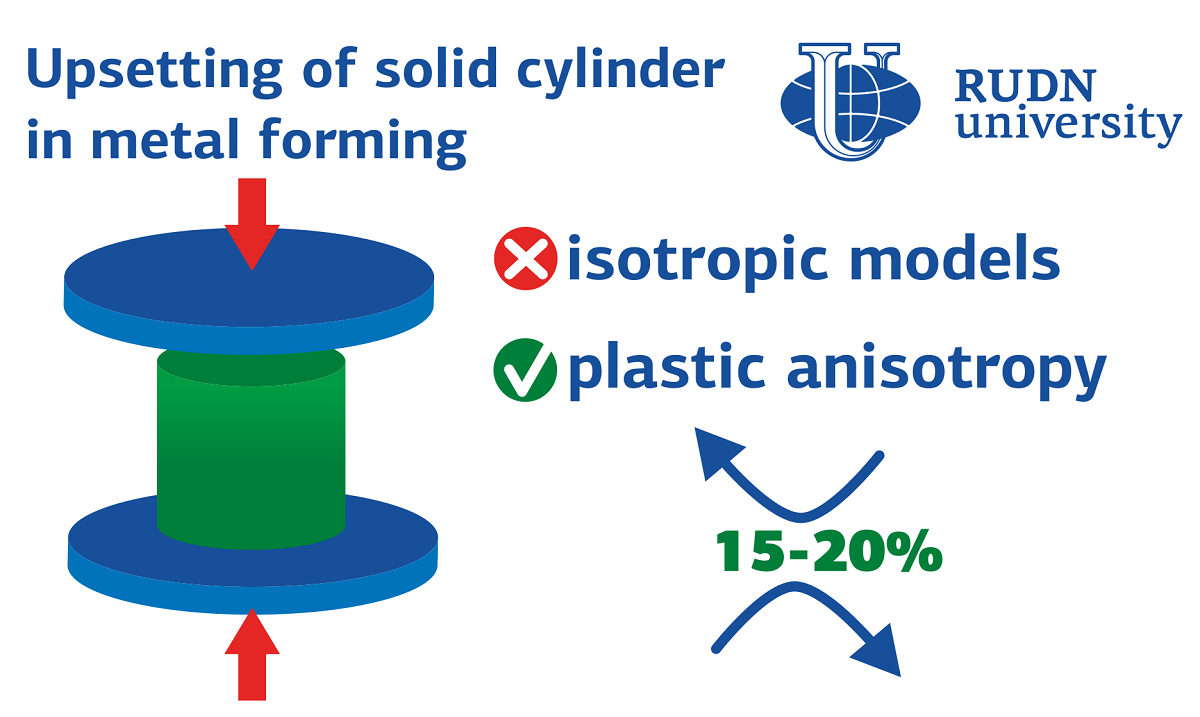RUDN University Engineers Propose a New Approach for Accounting Plastic Anisotropy in the Theoretical Description of Metal Forming Processes

The metal details are obtained by forming processes, that include for example rolling, extrusion, forging, as well as upsetting a cylindrical work piece (when it is increased in diameter with reduction in length). The practical application of upsetting goes together with theoretical models, but they are based on an initially incorrect assumption. It is usually assumed that the properties of the material are isotropic, that is, the same in all directions. In reality, this is not the case and the properties are anisotropic. RUDN University engineers proposed a new approach to theoretical calculations and showed that considering anisotropy significantly affects the cylinder draft.
“The analysis of cylinder’s upsetting is usually based on isotropic models. In addition, these solutions ignore the the regime of sticking on the friction surface, which always occurs in exact solutions near the axis of symmetry. In turn, the sticking regime leads to the appearance of a rigid region moving together with the plate. Neglecting the anisotropy of the material and the noted properties of exact solutions makes the practical value of these solutions questionable. Our overall motivation was to demonstrate, using a simple example, that plastic anisotropy, which is a very common property of metallic materials, should not be ignored in upper bound solutions for metal forming processes”, said Sergei Alexandrov, professor at RUDN University’s Department of Civil Engineering.
The researchers studied a problem in which an entire metal cylinder is pressed by two parallel plates. The speed of the plates is set, the dimensions of the cylinder are known. It is assumed that the physical properties of the cylinder are orthotropic, that is, they differ in three perpendicular directions. RUDN University engineers took the upper bound theorem as the basis of theoretical analysis. The Hill’s quadratic yield criterion was also used for calculations, which connects stresses along different axes in a certain combination.
RUDN University engineers tested the theoretical calculations on numerical examples — four materials with different anisotropies. The results showed that anisotropy affects the force that must be applied to upset a cylinder. The difference in strength was 15-20%. This is explained by the fact that due to anisotropy there are regions inside the cylinder that interact with each other in different ways, there is friction and sticking.
“A distinguishing feature of the solution is that plastic anisotropy and the existence of a rigid region are considered. The existence of the rigid region automatically means that there is a region of sticking friction. It can be concluded that Plastic anisotropy affects the limit load required to deform the specimen. It may increase or decrease the limit load as compared to the isotropic case”, said Sergei Alexandrov, professor at RUDN University’s Department of Civil Engineering.
The study is published in Materials.
The project to develop a cellular model of the placenta became the winner in the Scientific Materials category of the Young Scientists 3.0 competition, organized with the support of the Presidential Grants Foundation and T-Bank.
Ten scientific journals published by RUDN University have been included in the highest level of the state list of scientific publications, the White List.
Forests are not only the lungs of the planet, but also home to millions of species. However, it has remained unclear how underground interactions between trees and fungi affect forest species richness in different climatic conditions. Previous studies have yielded conflicting results: in some regions, the dominance of certain fungi reduced tree diversity, while in others it increased it.
The project to develop a cellular model of the placenta became the winner in the Scientific Materials category of the Young Scientists 3.0 competition, organized with the support of the Presidential Grants Foundation and T-Bank.
Ten scientific journals published by RUDN University have been included in the highest level of the state list of scientific publications, the White List.
Forests are not only the lungs of the planet, but also home to millions of species. However, it has remained unclear how underground interactions between trees and fungi affect forest species richness in different climatic conditions. Previous studies have yielded conflicting results: in some regions, the dominance of certain fungi reduced tree diversity, while in others it increased it.